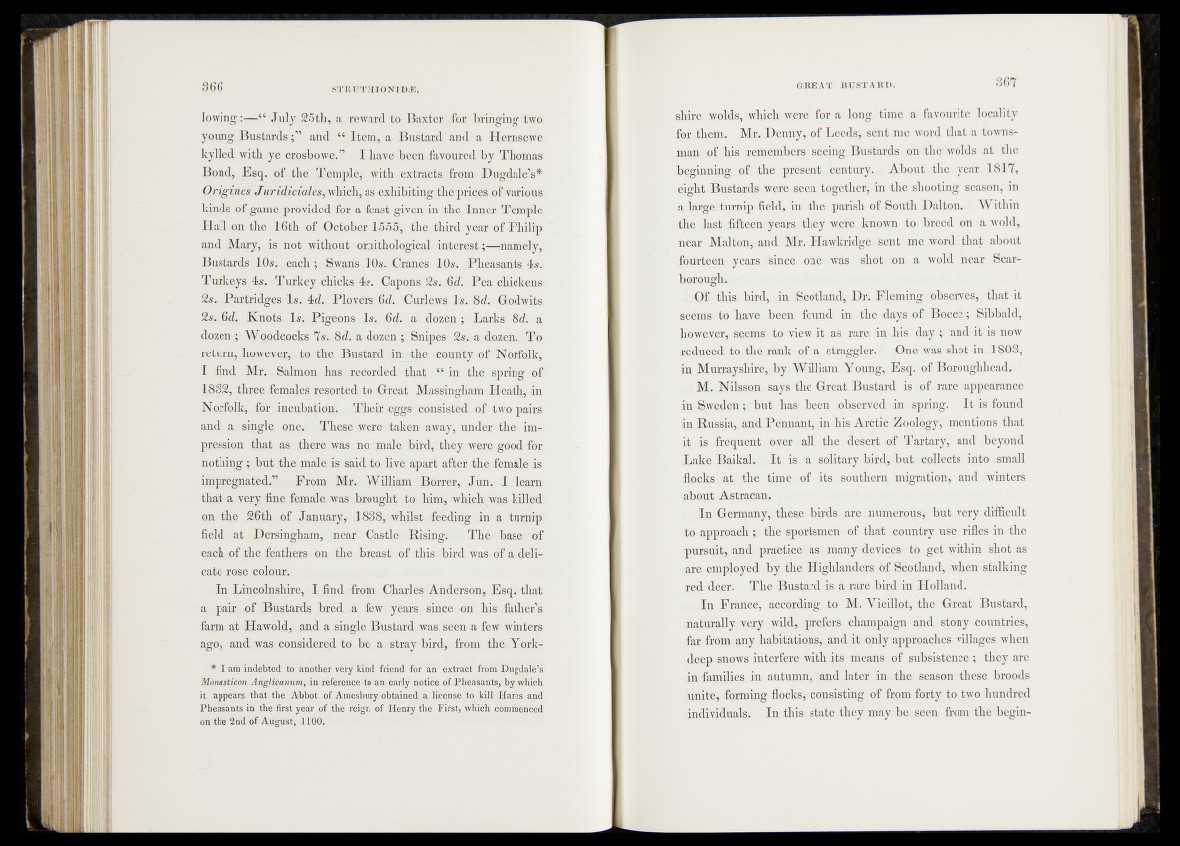
lowing:—“ July 25th, a reward to Baxter for bringing two
young Bustards;” and ;!4 Item, a Bustard and a llernsewe
kylled with ye crosbowe,” I have been favoured by Thomas
Bond, Esq. of the Temple, with extracts from Dugdale’s*
Origmes Juridiciales, which, as exhibiting the prices of various
kinds of game provided for a feast given in the Inner Temple
Hall on the 16th of October .1555.,; the third year of Philip
and Mary, is not without ornithological'.interest ; ^namely,
Bustards 10s. each'; Swans 10s. CraneSs 10s. Pheasants 4s.
Turkeys 4s. Turkey chicks 4s. .Capons'2s..'6d. Pea chickens
2s. Partridges Is. 4d. Plovers 6d. Curlews lsv 8rf. Godwins:
2s. 6d. Knots Is. Pigeons Is. 6d. a dozen; Larks 8<h a
dozen ; Woodcocks 7s. 8d. a dozen ;• Snipes: 2s.^a dozen,: To
return, however, to the Bustard in the county of.«-N or folk,
I find Mr. Salmon has, recorded that' Ifr&n ithe spring of
1882, three females resorted to Great Massingham Heath, in
Norfolk, for incubation^ Their eggs consisted^ bf two pairs
and a single, one.- These wer%<taken away, under the impression
that as ;Jh.ere was no male bird, :they-were good for
nothing ; but the main is said to live apart afterthe female is
impregnated.” From Mr. William Borrer, Jun.,»I learn,
that a very fine female was brought to him, which was killed
on the 26th of January, 1888,; whilst feeding , in a turstip
field at IXersingham, ;near Castle Rising. The- base"'of
each of the feathers on the breast of this bird was-of a delicate
rose colour.
In Lincolnshire, I find from Charles Anderson, Esq*-that
a pair of Bustards bred a few years- since. on his father’s
farm at Hawold, and a single Bustard was seen a few winters
ago, and was considered to be a stray bird, from the York-
* I am indebted to another very kind friend for‘ah extract from DugdaleV
Monasticon Anglicanum, in reference to- an early notice of Pheasants, by which
it appears that the Abbot of Amesbury obtained a license to kill Hares and
Pheasants in the first year of jthC reign, of Henry the First, which QO.mmCiiced
on the 2nd rif August, 1100.
shire wolds, which were for a long time a favourite locality
for them.. Mr. Denny, of Leeds, sent me word that a townsman
of,his remembers: seeing Bustards on the wolds at the
beginning a£s the present century. About the year 1817,
eight Bustards were iseen together, in the shooting season, in
a large, turnip-fije^dtj in -the parishu of: South Dalton, Within
the Jast -fifteen years they-,were-«known to' breed on a wold,
near .Maiton, and Mr. Hawkiadge -sent me word that about
fourteenye^rsk^nc^one ■ was shot on a wpld - near Scarborough*,.
gw
-1 Of thisivbfrdi, in iScotflaM^ Dr. Fleming-observes, fhaf it
feems• .to JfibvlfA®.enV fofi©d: in* »the 'dhySof- Boece; Sibbald,
- seems. tewiew it as rare'‘in h is:dasy$$ 'and it is now
reduced, fQ^tl^eerank jxfra straggler.-; Onewas^shdt in 1808-,
; Murra-yghjife^ by William,. Young,*- Esq. of Boroughhead.
M, Ni'lssffll^a-ystfhe Hreat .Bustard visnof rare appearance
in .observed in spring,/! Itls'found
in Russ|% and Pennant,; in his Arctic ^ooldgy, mentions that
^freqaeu kaoiver all ij^te fieserf of Tartary, and beyond
J|akeJ|ikMkaL I t is.; a sloldtary-bird, bute colloctSi mt© small
figeks «at the timj§i^fedts~.'' southern migration, and winters
Astrabanx yi
III Germany, these birds, are ija|H^erohs,v’bu.t very difficult
to appreiaefcthe/Sportsmeht of that-j country u'Se.frifles in the
pursuit, andtipractice ,as many^de^iees.f tefc ^st within shofras
are employed fiy the, Highlandejs-fifi Scotland,-when stalking
red dqer: The Bustar<^js£a!rare, bird^y Hollands ,
In France^ according*to M.^leillot, the Great Bustard,
naturally yery;, wild,^prefers champaign and stony countries,
far from any habitations ,and it only approached villages when
deep snows mterfeipwith its means of subsistence.'; they are
in families, in autumn^ and later in the; seasrniJth.es©? broods
unite, forming flo6ksjyoonsisting^®f from forty tb two hundred
individuals. In this' state.they-«may bei seen, .from the begin